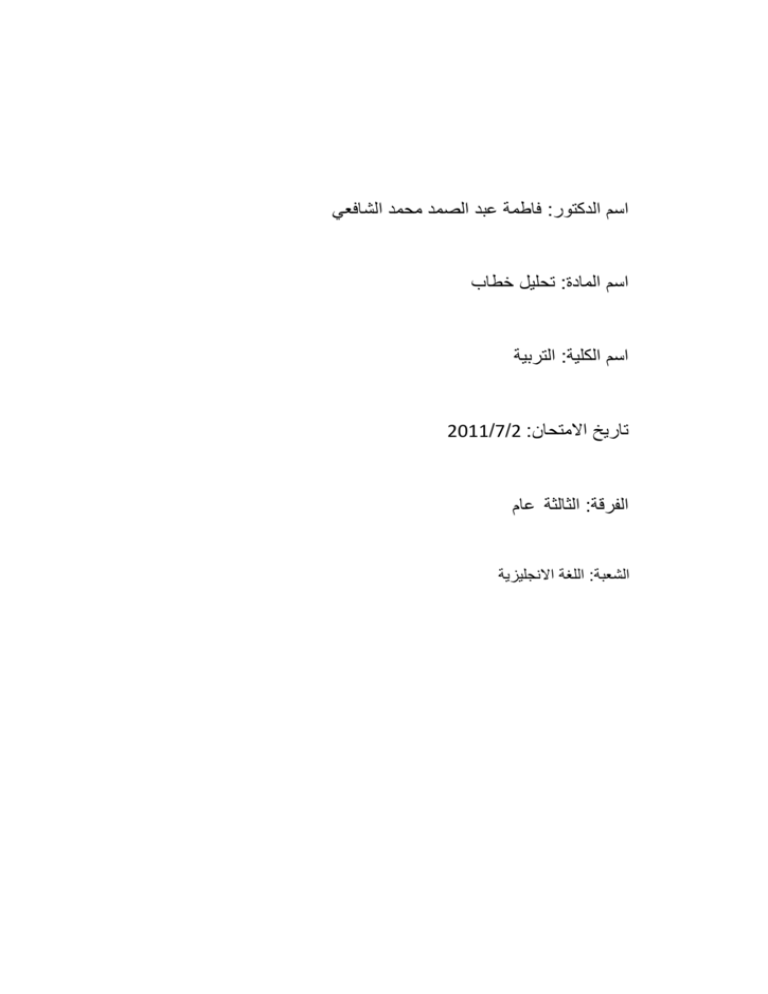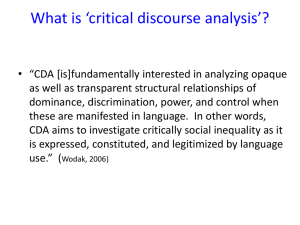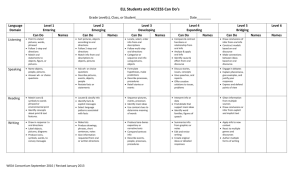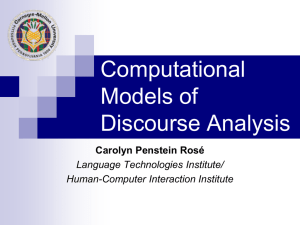1.Speech Act Theory
advertisement

اسم الدكتور :فاطمة عبد الصمد محمد الشافعي اسم المادة :تحليل خطاب اسم الكلية :التربية تاريخ االمتحان2011/7/2 : الفرقة :الثالثة عام الشعبة :اللغة االنجليزية Answer the following question: Write to discuss ONE only of the following: 1.Speech Act Theory Making a statement may be the paradigmatic use of language, but there are all sorts of other things we can do with words. We can make requests, ask questions, give orders, make promises, give thanks, offer apologies, and so on. Moreover, almost any speech act is really the performance of several acts at once, distinguished by different aspects of the speaker's intention: there is the act of saying something, what one does in saying it, such as requesting or promising, and how one is trying to affect one's audience. The theory of speech acts is partly taxonomic and partly explanatory. It must systematically classify types of speech acts and the ways in which they can succeed or fail. It must reckon with the fact that the relationship between the words being used and the force of their utterance is often oblique. For example, the sentence 'This is a pig sty' might be used nonliterally to state that a certain room is messy and filthy and, further, to demand indirectly that it be straightened out and cleaned up. Even when this sentence is used literally and directly, say to describe a certain area of a barnyard, the content of its utterance is not fully determined by its linguistic meaning--in particular, the meaning of the word 'this' does not determine which area is being referred to. A major task for the theory of speech acts is to account for how speakers can succeed in what they do despite the various ways in which linguistic meaning underdetermines use. In general, speech acts are acts of communication. To communicate is to express a certain attitude, and the type of speech act being performed corresponds to the type of attitude being expressed. For example, a statement expresses a belief, a request expresses a desire, and an apology expresses a regret. As an act of communication, a speech act succeeds if the audience identifies, in accordance with the speaker's intention, the attitude being expressed. Some speech acts, however, are not primarily acts of communication and have the function not of communicating but of affecting institutional states of affairs. They can do so in either of two ways. Some officially judge something to be the case, and others actually make something the case. Those of the first kind include judges' rulings, referees' calls and assessors' appraisals, and the latter include include sentencing, bequeathing and appointing. Acts of both kinds can be performed only in certain ways under certain circumstances by those in certain institutional or social positions. A thorough discussion of the speech act theory may include the following items: 1. Levels of speech acts 2. Communicative and conventional speech acts 3. Types of speech acts a. Declaratives: b. Directives: c. Commissives d. Expressives e. Behabitatives 4. Direct, indirect and nonliteral speech acts 5. Philosophical importance of speech act theory It is also plausible to add examples where possible to support the answer. 2.Critical discourse analysis Critical discourse analysis (CDA) is a type of discourse analytical research that primarily studies the way social power abuse, dominance, and inequality are enacted, reproduced, and resisted by text and talk in the social and political context. With such dissident research, critical discourse analysts take explicit position, and thus want to understand, expose, and ultimately resist social inequality. Some of the tenets of CDA can already be found in the critical theory of the Frankfurt School before the Second World War (Agger 1992b; Rasmussen 1996). Its current focus on language and discourse was initiated with the "critical linguistics" that emerged (mostly in the UK and Australia) at the end of the 1970s (Fowler et al. 1979; see also Mey 1985). CDA has also counterparts in "critical" developments in sociolinguistics, psychology, and the social sciences, some already dating back to the early 1970s (Birnbaum 1971; Calhoun 1995; Fay 1987; Fox and Prilleltensky 1997; Hymes 1972; Ibanez and Iniguez 1997; Singh 1996; Thomas 1993; Turkel 1996; Wodak 1996). As is the case in these neighboring disciplines, CDA may be seen as a reaction against the dominant formal (often "asocial" or "uncritical") paradigms of the 1960s and 1970s. CDA is not so much a direction, school, or specialization next to the many other "approaches" in discourse studies. Rather, it aims to offer a different "mode" or "perspective" of theorizing, analysis, and application throughout the whole field. We may find a more or less critical perspective in such diverse areas as pragmatics, conversation analysis, narrative analysis, rhetoric, stylistics, sociolinguistics, ethnography, or media analysis, among others. Crucial for critical discourse analysts is the explicit awareness of their role in society. Continuing a tradition that rejects the possibility of a "value-free" science, they argue that science, and especially scholarly discourse, are inherently part of and influenced by social structure, and produced in social interaction. Instead of denying or ignoring such a relation between scholarship and society, they plead that such relations be studied and accounted for in their own right, and that scholarly practices Critical Discourse Analysis 353 be based on such insights. Theory formation, description, and explanation, also in discourse analysis, are sociopolitically "situated," whether we like it or not. Reflection on the role of scholars in society and the polity thus becomes an inherent part of the discourse analytical enterprise. This may mean, among other things, that discourse analysts conduct research in solidarity and cooperation with dominated groups. Critical research on discourse needs to satisfy a number of requirements in order to effectively realize its aims: • As is often the case for more marginal research traditions, CDA research has to be "better" than other research in order to be accepted. • It focuses primarily on , social problems and political issues, rather than on current paradigms and fashions. • Empirically adequate critical analysis of social problems is usually multidisciplinary. • Rather than merely describe discourse structures, it tries to explain them in terms of properties of social interaction and especially social structure. • More specifically, CDA focuses on the ways discourse structures enact, confirm, legitimate, reproduce, or challenge relations of power and dominance in society. Fairclough and Wodak (1997: 271-80) summarize the main tenets of CDA as follows: 1. CDA addresses social problems 2. Power relations are discursive 3. Discourse constitutes society and culture 4. Discourse does ideological work 5. Discourse is historical 6. The link between text and society is mediated 7. Discourse analysis is interpretative and explanatory 8. Discourse is a form of social action. Whereas some of these tenets have also been discussed above, others need a more systematic theoretical analysis, of which we shall present some fragments here as a more or less general basis for the main principles of CDA. Details about these aims of critical discourse and language studies include discussion of: 1. Conceptual and Theoretical Frameworks include discussion of: a) Macro vs. micro b) Power as control which deals with: 1. control of public discourse 2. mind control 2 Research in Critical Discourse Analysis Most discourse studies dealing with any aspect of power, domination, and social inequality have not been explicitly conducted under the label of CDA. Some of these studies, however, discuss the following issues: 1. Gender inequality 2. Media discourse 3. Political discourse 4. Ethnocentrism, antisemitism, nationalism, and racism In all these cases, power and dominance are associated with specific social domains (politics, media, law, education, science, etc.), their professional elites and institutions, and the rules and routines that form the background of the everyday discursive reproduction of power in such domains and institutions. The victims or targets of such power are usually the public or citizens at large, the "masses," clients, subjects, the audience, students, and other groups that are dependent on institutional and organizational power.






